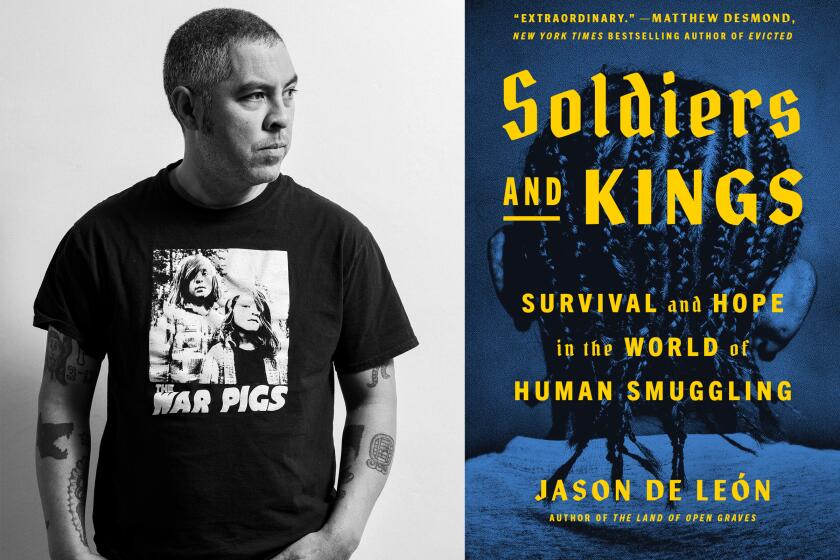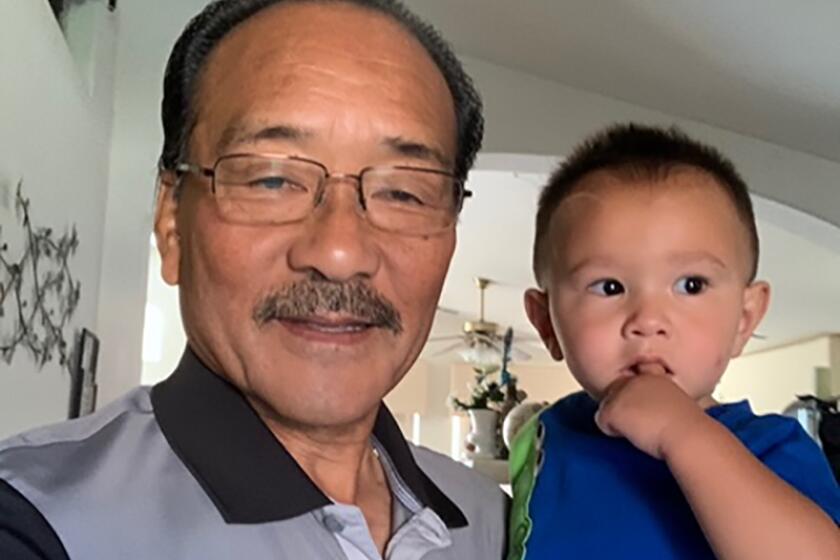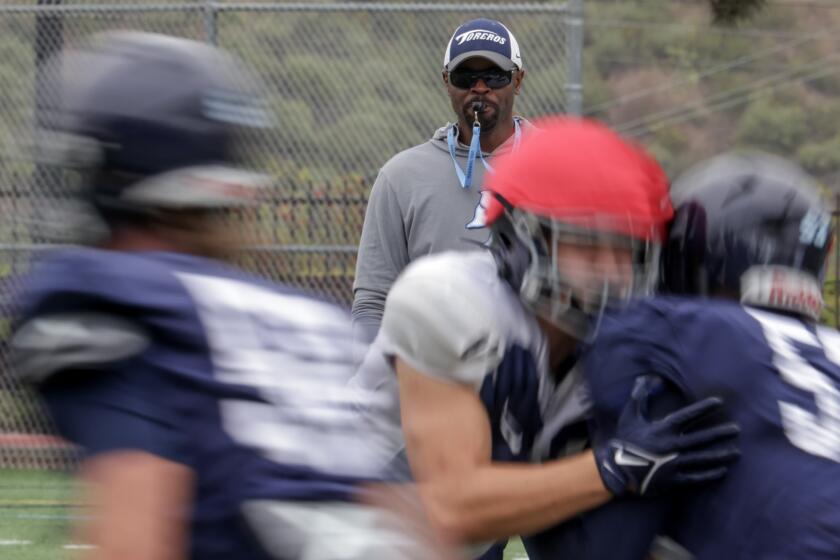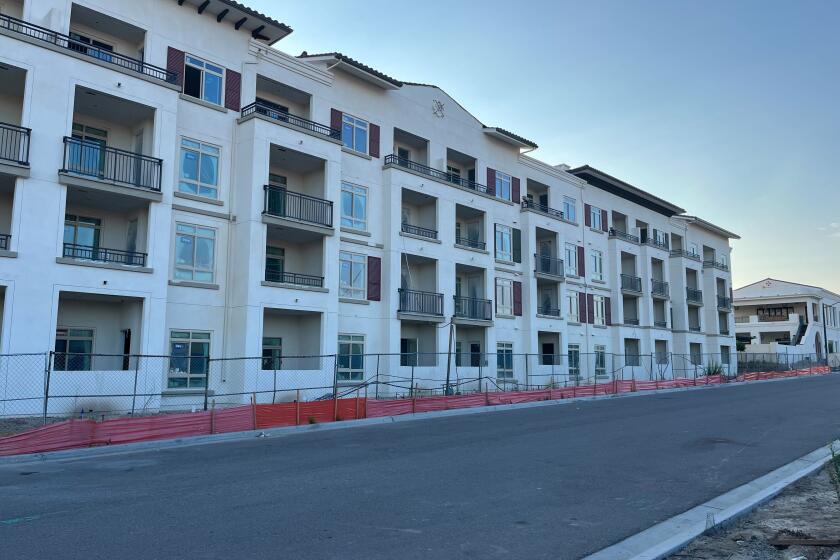Supporting LGBTQ kids in schools is win-win for all students, experts say
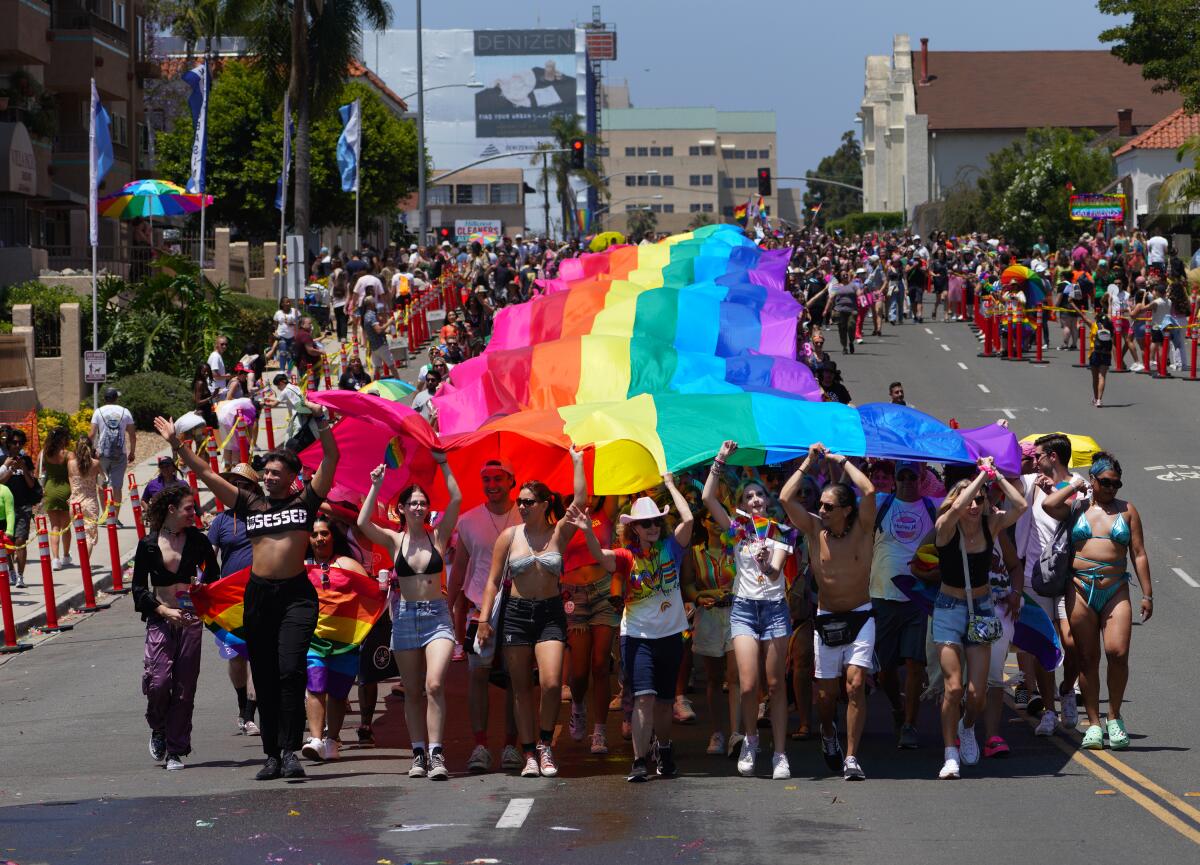
Vincent Pompei, an assistant professor at San Diego State University, and Emily Fisher, a professor in the school psychology program at Loyola Marymount University, discuss recent California legislation that increases support for LGBTQ youth in schools
Recent legislation signed by Gov. Gavin Newsom last week includes a number of bills that bolster support for LGBTQ youth in schools. Advocates and researchers say that continued protections are necessary in the face of increasing policies and legislation that specifically target students to exclude them from participating in sports, from classroom discussions and lessons that include representation of diverse families, from feeling safe in their identities and expressions of those identities at school.
“And it’s troubling, but we have a reality here in California where some people say, ‘Gosh, do we even need to do LGBTQ inclusion work? We live in a blue state,’” said Vincent Pompei, an assistant professor in the doctoral program for educational leadership at San Diego State University, and a member of a state advisory committee to create online training courses for school faculty to support LGBTQ students who are experiencing bullying, harassment, discrimination, or rejection at school or at home. “Well, advocates like myself, who are entrenched in this work, have always known that not to be true, but it’s becoming more and more clear what our current state is of LGBTQ young people living and trying to survive and thrive in California,” he said, citing survey statistics on the mental and emotional health and well-being of LGBTQ kids compared to their heterosexual, cisgender peers.
To discuss about some of these new bills, the arguments around notifying parents if a child prefers to identify at school in ways that don’t align with their assigned gender at birth, and what may shift a collective understanding of the experiences of LGBTQ students to one of greater support and inclusivity, Pompei is joined in conversation by Emily Fisher, a professor in the school psychology program at Loyola Marymount University where her work is focused on increasing school support and creating safe and supportive learning environments for LGBTQ-plus students. (These interviews have been edited for length and clarity. )
Q: California is among a group of states rated by the Human Rights Campaign to have a broad range of equality protections for LGBTQ people; what are your thoughts on these recent bills and why they’re necessary?
Fisher: There’s been a lot of attempts to try to deny the existence and the basic humanness of LGBTQ individuals. What schools have done, and districts that have tried to put policies in place, is that they don’t even acknowledge that LGBTQ youth exist. I think that the bills that the governor signed [last] weekend really say that there are basic human rights that are afforded to all young people and that your sexual orientation or gender identity should not determine your right to exist. You should be able to be yourself, you should feel supported, and you should be able to access the academic and social curriculum that your peers do.
Pompei: My wish is that we wouldn’t need legislation to protect the human and civil rights of another human being. Unfortunately, because of bias and stigma and misinformation, we have to pass policies that provide further protection to prevent harm, but also to send a message to vulnerable populations — in this case, LGBTQ young people — that even in light of these attacks that they’re experiencing, the state of California and their government have their back. They are listening to the voices of LGBTQ young people, to the research about what these students need in order to learn, in order to engage in their education, and in order to thrive in school and beyond. Part of me wishes that this was not necessary; that we were just decent human beings and said, ‘Hey, you know, everyone’s treated with dignity and respect.’ That’s, unfortunately, not the world that we live in today.
Any time I hear a school board passing anti-LGBTQ policies or proposing anti-LGBTQ policies, they’re never discussing the disparities that we continue to see, and the data as it relates to LGBTQ students compared to their non-LGBTQ peers. That relates to feeling connected, feeling safe, feeling cared for, experiencing mental health challenges, and even suicide. They’re passing policies without talking about what the school district is going to do to address them. From the California Healthy Kids Survey, the latest public data that they have available on their dashboard for San Diego County, shows that 68 percent of LGB students and 79 percent of trans students indicated chronic sadness or hopelessness in the past year, compared to 25 percent of straight students and 30 percent of cisgender students. Forty-four percent of LGB students and 57 percent of trans students in our county seriously considered attempting suicide in the past year, compared to 9 percent of straight students and 12 percent of cisgender students. So, it’s troubling to me that we’re passing policies rooted in transphobia, homophobia, biphobia, rather than actually looking at what the research says about what will help all students, including LGBTQ students, learn and engage and thrive in school. It’s hard to answer that question without painting a larger picture, but I can say that yes, I’m excited, I’m celebrating, but I’m also sad that we have to pass laws to protect students from our elected officials who have made an oath to serve all children in public school. It’s troubling to me.
Q: One of them, SB 857, creates an advisory task force to identify the needs of LGBTQ students in schools. From your research and work in this area, can you talk about successful ways to build a school climate that is supportive of its LGBTQ students?
Fisher: Fortunately, there has been a lot more research over the past 20 years or so that has documented the needs of LGBTQ young folks in social settings, academic settings, and in society at large. We see that LGBTQ people are bullied, harassed, discriminated against, oppressed more than those who identify as cisgender, as heterosexual. My understanding of what this task force will look at is the experiences of LGBTQ youth in California schools to see where they are in terms of making sure that there is programming and support for them, and where there can be more and what schools can do to provide more. Apart from the research on school climate, education has been shown to have an impact. For instance, they have found that professional development for teachers and staff does have a deep impact on the experiences of LGBTQ young people. So, not only does it sensitize the adults to what those experiences are, but it better prepares them to respond when there is bullying, harassment, name calling, et cetera. Another thing that has been shown to be particularly effective is to have diverse curriculum. When we talk about a diverse curriculum, we are talking about that across a broad spectrum of diversity that includes sexual orientation and gender identity. While there has been a lot more talk about sexuality education, and I think that inclusion is critical, it also just involves showing LGBTQ kids reflections of themselves in the curriculum. Also, it encourages other students to learn about the broad spectrum of human diversity and can change social attitudes toward specific groups of people.
Pompei: Yes, here’s the good news to that question. The good news is that we actually have well-established research that says that when schools do certain things, not only do LGBTQ students feel safer and more connected at school, but so do their non-LGBTQ peers. So, it’s a win-win. From a researcher’s perspective, sharing as an educational leader and researcher, this is also common knowledge that when students feel safe and connected, whether they’re LGBTQ or not, academic achievement rises, attendance improves, and the likelihood that they will graduate college and be career-ready also improves, along with the mental health measures. I would encourage schools to follow the evidence-based practices, which are also supported in California’s current education codes. Luckily, we have passed policies and laws in California that are directly aligned to the research that I’m talking about, so the laws that support and guide educators in California public schools are directly aligned to what schools can do to ensure that students who are LGBTQ don’t experience discrimination, bullying, harassment, and intimidation.
Q: In July, the Chino Valley Unified School District adopted a policy requiring teachers to notify parents if their child identifies as transgender, wants to use a name or pronoun that’s different from what’s on their birth certificate, if the child requests access to gender-based sports, or if they want to use a bathroom that doesn’t match their assigned gender at birth. (The state attorney general later sued the district, halting the policy while the lawsuit is ongoing.) SB 760 seems to address this by requiring schools to provide at least one gender-neutral restroom by July 1, 2026. What is your response to arguments being made in favor of these kinds of notification policies, saying that parents have a right to know about the decisions their children are making at school and a right to the way they choose to raise their children?
Fisher: I do understand parents’ position, and if we were to do more to work with parents on an understanding of how sexual orientation and gender identity develop and are expressed by young people, that would be a different thing. If we were doing parent education, parent nights where parents could come and ask questions and talk, where parents could actually see the research on how critical this understanding is for students’ mental health and wellbeing, that would be more meaningful work than these types of policies. I know that there are districts that have been putting caveats in place on their own with these policies that say that [notification is required] unless there is a fear that the child will be in danger by notifying the parents. Hopefully, 75 percent of the time, parents will be supportive. They may have questions, but they will approach it in a way of wanting to understand and support. Even if they don’t like it, they want to understand and support their child. It’s the other group that can cause long-term, detrimental consequences that there is concern for. Where I come from is, if there is one student who attempts suicide because they’re in an unsupportive family environment; or they are forced to run away because of what is happening to them; or they’re put into some kind of “conversion therapy,” which we know has horrible outcomes, that’s one student too many. As educators, our very first act is to protect students and to do no harm, and I think that the potential for harm to occur is much greater, so until there is more ability to really provide parents with education and with resources to help mitigate parents reactions, I think those things need to happen first. The notification has the potential for negative consequences, so I think there’s a lot of work that needs to be done prior to that, and the idea is to help parents know how to respond to that notification or disclosure. I will also comment that a part of exploring their gender identity is to kind of try on different aspects of that. Let’s say they identify as transgender and they’re going through their transition, we talk about a social transition first where they are trying a different name or pronouns, or they start dressing differently, or styling their hair differently. It’s not as if a young person has this all figured out, but that type of exploration intersects with other aspects of their life. Like, trying different sports or extracurricular activities, like art. We want them to find out who they are and what connects with them, so the good news is they have more access to positive images of gender diverse people. It also means that they might be experimenting with things like social transitions, changing their name or pronouns earlier, and that might make people feel uncomfortable. Parents don’t always know how to respond, or the damage that a response can have. I don’t think that there are parents out there who want to harm their children. That is not a motivation, and I never think it is, but they may not know that how they respond can do long-term damage. So, how do we proactively help parents? Parents need to know how to talk to kids about this and I’d say this needs to start in kindergarten, you can’t wait until kids are in middle school to have these conversations with parents. Parents need to learn about this much earlier, as uncomfortable as it might be.
Pompei: I just want to clarify that SB 760 would not fix what’s happening in Chino Valley. Based on another law that passed, I think, five or six years ago, they’re already required to update any single-user restroom on campus to an all-gender restroom, meaning one toilet, one user at a time. The problem is that some schools didn’t have any single-user restrooms on campus; SB 760 is going to tell school districts that if you don’t already have construction of a single-user restroom, then we’re going to have to create one. Gender-neutral restrooms are not just for LGBTQ students; they’re for any student who would feel most comfortable in a restroom by themselves.
Back to the Chino Valley School District and them passing this in the guise of parental rights. Parents have always had the right to raise their children in the way that they choose to. They always have had that right and continue to have that right. If a parent is concerned that their child may hide such a vital part of their identity from them, I honestly encourage parents to ask themselves this tough question: What message may they be sending to their child that their love and support is conditional, that they should go through great lengths to hide who they are to the people in their lives who are supposed to love and care for them the most? When LGBTQ young people live in a home that is highly rejecting, research has found that those young people are eight times more likely to attempt suicide. I wish Chino Valley would have answered the question of what are they going to do to mitigate that? Research has also found that up to 40 percent of homeless youth across the country identify as LGBTQ. These young people are literally tossed out of their own homes with no place to go. Let’s imagine we out a trans or non-binary child to the family and that family is unaccepting and not affirming. When that child feels like, ‘OK, my family knows who I am and they’re still not calling me by the name I asked them to call me and by the pronouns that I go by’ it significantly increases the suicide risk. So, it concerns me when we have policies without also talking about what the research tells us. The state of California has sued knowing that this decision has the potential to cause tremendous harm, including in the lives of some of our most vulnerable children.
Q: Research from Gallup notes increases in support for legalizing same-sex marriage; in people identifying as LGBT, including among Black, Latino, and White adults; and among a majority of people, globally, who believe that where they live is also a good place for gay or lesbian people to live. We’re also seeing record numbers of anti-LGBTQ bills introduced in legislatures across the country, with more than half focused on LGBTQ youth. Can you help us understand this targeting of children? Your perception on how they’ve been placed in this position?
Fisher: I think it’s very complex, and I think that as there’s greater social acceptance, there’s also a sort of blowback to that. People kind of see it as “adults are adults, they can make their own decisions,” but kids are still much more vulnerable. Clearly, there are still huge amounts of discrimination and civil rights that are excluded for LGBTQ people. I think that, where young people are involved, there’s still a very paternalistic approach when it comes to civil rights for young people. This is a bit of speculation, but I think it’s coming out of fear—fear for their children, fear of what it says about their kids, what it says about their family, how they’ll be accepted in their community. I think religion plays a role in that fear, as well, where there’s a lack of understanding and acceptance. I don’t say that religion is a bad thing; I think that religion can also be a place where families and young people get support. I think that public education has this sort of broader purpose of not just academics, there’s a social part, as well. I think that parents want to manage that social curriculum and it’s scary to them that their kids are learning about things that they themselves are not familiar with, or don’t know enough about. This is why I do what I do, I work in education and I truly believe that children are our future. I am hopeful that with each generation there’s this increase in terms of our overall social acceptance, but it is concerning to me that kids who are, in some ways, the most vulnerable are most affected by these policies and this intolerance. They don’t have as much autonomy, they can’t choose where they live, they can’t choose where they go to school, they are reliant on adults for resources, for protection, for basic human needs. So, they are aware of the decisions that adults are making and I think that’s the danger in these bills. Frankly, we don’t want to think about young people as these sexual beings, but sexuality is a part of our humanity and we can’t say that at school, this doesn’t exist. You are who you are, and you bring yourself and your lived experiences to school. We should have a way to have these conversations that allows questions and curiosity, allows for a difference of opinion, as long as it doesn’t deny somebody’s existence.
Pompei: I’ll start by saying that anti-LGBT groups have been very effective at communicating and lobbying politicians. Again, not using well established research; they’re using personally held beliefs, perhaps even religious beliefs, to kind of legislate education policy in direct response to what you just shared. There’s actually a very strong correlation with what you just shared about the growing percentage of Americans and people across the world who are more and more accepting, to growing levels of people who don’t support those groups getting more strategic, louder, and organizing. I think the other issue is that some politicians have decided to politicize LGBTQ inclusion in schools. They are elevating misconceptions, biases and untruths about what LGBTQ inclusion efforts even mean in K-12 education, and what LGBTQ identities mean in the first place. There are things that they’re uttering like, “recruiting,” “grooming,” “forcing your kids to be LGBTQ,” “sexualizing kids.” None of those are actually rooted in fact, but if they repeat it enough times, that causes people to start believing it and they’re taking advantage that it actually does cause discomfort in people and the primary reason for that is because of the lack of information and awareness. That’s why education is so critically important. When we educate folks and we shed light on these things, we chip away at the biases, we chip away at the misconceptions, and we start to open hearts and minds. Then, we start to treat one another with kindness and respect, and that’s what schools are aiming to do with their LGBTQ inclusion efforts. If children are experiencing bullying behavior in schools, not only is it impacting that child’s ability to learn and engage in the classroom, not only does it impact their attendance, it actually starts to negatively impact the school climate for other students who may witness that. I always tell a parent who doesn’t want their child going to a school where they’re working on LGBTQ inclusion that a school that fails to acknowledge that LGBT young people are disproportionately impacted by bullying, that’s going to negatively impact their child as well.
Get Essential San Diego, weekday mornings
Get top headlines from the Union-Tribune in your inbox weekday mornings, including top news, local, sports, business, entertainment and opinion.
You may occasionally receive promotional content from the San Diego Union-Tribune.

